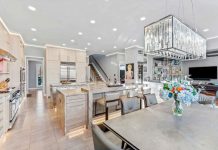
If you’ve ever driven in the North Baltimore neighborhood of Guilford and suddenly slammed on your brakes at the park-like intersection of Greenway, St. Paul Street and University Parkway, you’re not alone. You are, in fact, a familiar sight— and sound— to Bill Roberts, who lives in the French cottage-style house at 3700 Greenway.
“Happens all the time,” says Roberts. “Especially in the spring when the yard is in bloom.”
Roberts had a similarly startled reaction when he and his wife, Ilene, first happened upon the house in 1990. Moving from Los Angeles, they were astounded by Baltimore real estate prices, and even more so by the elegance of this house and its immediate neighbor, a “fraternal twin,” as Roberts calls it. “I thought they were some of the most beautiful houses I had ever seen.”
The Roberts’ house and its twin at 3701 St. Paul, which is owned by Judson and Marya Flanagan, are the so-called Gateway Houses to Guilford, two similar, yet subtly different, private residences designed by architects Edward L. Palmer Jr. and William D. Lamdin.
 From 1907, when Palmer served as chief architect for The Roland Park Co., to 1920, when Lamdin joined the firm, on up through World War II, Palmer and Lamdin created some of the most distinctive, graceful, livable buildings in Baltimore. They built more than 200 houses, as well as dozens of other buildings, including the white-steepled Second Presbyterian Church in Guilford, the twin-domed Saint Casimir Church in Canton and apartment buildings boasting Old World charm throughout the city.
From 1907, when Palmer served as chief architect for The Roland Park Co., to 1920, when Lamdin joined the firm, on up through World War II, Palmer and Lamdin created some of the most distinctive, graceful, livable buildings in Baltimore. They built more than 200 houses, as well as dozens of other buildings, including the white-steepled Second Presbyterian Church in Guilford, the twin-domed Saint Casimir Church in Canton and apartment buildings boasting Old World charm throughout the city.
The Gateway Houses made the firm’s reputation, according to Baltimore architect Walter Schamu, senior partner of SMG Architects, Inc., who has been studying the architects’ work for more than 30 years. Both men were born and raised in Baltimore— Palmer attended Johns Hopkins and the University of Pennsylvania, while Lamdin went to Cornell University— and both returned to the city to practice. Lamdin died in 1945 at the age of 53; Palmer lived until age 75, dying in 1952.
Schamu delights in pointing out the details that make Palmer and Lamdin’s work immediately recognizable. Gazing at the Gateway Houses, he calls attention to the roofs. “Look at that flare at the edge,” he says, “that little kick at the end of the slate. It’s an easing of the roofline before it hits the gutter.” It’s a tiny grace note that’s easily overlooked, but once you see it, you realize it’s one of the reasons the houses look so pretty.
 Trademark Palmer and Lamdin features also include unusual brick chimneys— known as Jacobean or diamond-stack chimneys— that appear to twist as they rise. And their houses are built with a combination of different types of masonry. Drive through Guilford, and Homeland, and you’ll start to notice other refinements: there’s a lot of texture to P&L houses, the facades both project and recede, your eye dances along the rooflines. Flourishes such as dovecotes, turrets, round windows mixed with rectangular ones and the aptly named “eyebrow dormers” peek out. (Lamdin, says Schamu, learned a lot from French architecture during his tour of duty in World War I.) The distinctive slate roofs are composed of hand-cut graduated tiles of green, gray and red, with bigger tiles at the bottom, smaller ones at the top, increasing the sense of steepness to the pitch.
Trademark Palmer and Lamdin features also include unusual brick chimneys— known as Jacobean or diamond-stack chimneys— that appear to twist as they rise. And their houses are built with a combination of different types of masonry. Drive through Guilford, and Homeland, and you’ll start to notice other refinements: there’s a lot of texture to P&L houses, the facades both project and recede, your eye dances along the rooflines. Flourishes such as dovecotes, turrets, round windows mixed with rectangular ones and the aptly named “eyebrow dormers” peek out. (Lamdin, says Schamu, learned a lot from French architecture during his tour of duty in World War I.) The distinctive slate roofs are composed of hand-cut graduated tiles of green, gray and red, with bigger tiles at the bottom, smaller ones at the top, increasing the sense of steepness to the pitch.
P&L houses are also, says Schamu, “uniquely sited on impossible sites”— hilly terrain and oddly shaped lots. (Lamdin actually went to Switzerland on The Roland Park Co.’s dime to study how to build houses into steep hillsides.) “Every time,” Schamu says of the architects, “they won. I don’t think they ever did a bad building.”
 It was the architecture that first attracted Judson and Marya Flanagan to 3701 St. Paul. Judson values “the sense of balance, of proportion, the use of different shapes.” The Flanagans share with the Roberts’ home a central courtyard, pond, decorative well and wrought-iron gate, all designed by Palmer and Lamdin. Certain touches, however, are different: where the Roberts have a sunroom and slate patio, the Flanagans have an Italianate outdoor loggia, “where we practically live in the summer,” says Marya. European elements such as Gothic arches and French doors that lead to the outside are typical.
It was the architecture that first attracted Judson and Marya Flanagan to 3701 St. Paul. Judson values “the sense of balance, of proportion, the use of different shapes.” The Flanagans share with the Roberts’ home a central courtyard, pond, decorative well and wrought-iron gate, all designed by Palmer and Lamdin. Certain touches, however, are different: where the Roberts have a sunroom and slate patio, the Flanagans have an Italianate outdoor loggia, “where we practically live in the summer,” says Marya. European elements such as Gothic arches and French doors that lead to the outside are typical.
Words that come up again and again when homeowners talk about P&L houses are “livable,” “unpretentious,” “elegant,” “social.” Grace and Howard Pollack and their three children moved into a P&L house at 4205 Underwood Road in 2006. Grace says she knew immediately that this was the house she wanted to live in. “It’s full of warmth and character,” she says. “It’s inviting.”
With a corner entrance ensconced in a copper-roofed stone turret, the house seems straight out of a fairy tale. Though it looks deceivingly small, it’s actually quite spacious, and contains a spectacular treasure: a floor-to-ceiling stained-glass window on the staircase landing depicting a clematis vine. A sunroom and the ubiquitous French doors open up the house, and light pours in through windows both square and round. “It’s a great house for entertaining,” says Pollack. “It’s all about the flow.”
 “Flow” is exactly the word used by Bill and Pat Murphy of 7 Charlcote Place, who live in another classic Palmer and Lamdin. “It’s a very gracious house,” says Bill Murphy, “great for entertaining. It has a country garden feel.”
“Flow” is exactly the word used by Bill and Pat Murphy of 7 Charlcote Place, who live in another classic Palmer and Lamdin. “It’s a very gracious house,” says Bill Murphy, “great for entertaining. It has a country garden feel.”
The Murphys didn’t know anything about the architects when they moved to the address in 2002, but now, says Bill, he recognizes the distinctive chimneys all over the neighborhood.
Once you recognize a Palmer and Lamdin, it becomes a kind of game to go around the city identifying them. Each one, says Schamu, is a unique response to a specific site and client’s needs. Yet they all display, in his words, “a master’s touch. Those guys had a lot of fun creating these houses.”
For more information on the Palmer & Lamdin houses, as well as location addresses, visit the University of Baltimore Langsdale Library Special Collections website.




